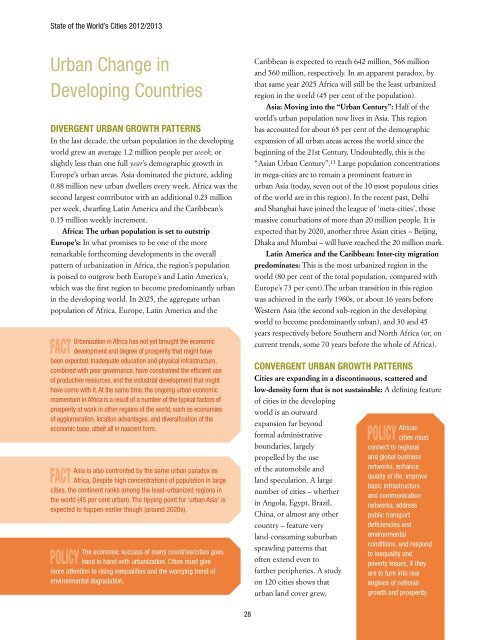state of the world's cities 2012/2013 - United Nations Sustainable ...
state of the world's cities 2012/2013 - United Nations Sustainable ...
state of the world's cities 2012/2013 - United Nations Sustainable ...
Create successful ePaper yourself
Turn your PDF publications into a flip-book with our unique Google optimized e-Paper software.
State <strong>of</strong> <strong>the</strong> World’s Cities <strong>2012</strong>/<strong>2013</strong>Urban Change inDeveloping CountriesDivergent Urban Growth PatternsIn <strong>the</strong> last decade, <strong>the</strong> urban population in <strong>the</strong> developingworld grew an average 1.2 million people per week, orslightly less than one full year’s demographic growth inEurope’s urban areas. Asia dominated <strong>the</strong> picture, adding0.88 million new urban dwellers every week. Africa was <strong>the</strong>second largest contributor with an additional 0.23 millionper week, dwarfing Latin America and <strong>the</strong> Caribbean’s0.15 million weekly increment.Africa: The urban population is set to outstripEurope’s: In what promises to be one <strong>of</strong> <strong>the</strong> moreremarkable forthcoming developments in <strong>the</strong> overallpattern <strong>of</strong> urbanization in Africa, <strong>the</strong> region’s populationis poised to outgrow both Europe’s and Latin America’s,which was <strong>the</strong> first region to become predominantly urbanin <strong>the</strong> developing world. In 2025, <strong>the</strong> aggregate urbanpopulation <strong>of</strong> Africa, Europe, Latin America and <strong>the</strong>FACTUrbanization in Africa has not yet brought <strong>the</strong> economicdevelopment and degree <strong>of</strong> prosperity that might havebeen expected. Inadequate education and physical infrastructure,combined with poor governance, have constrained <strong>the</strong> efficient use<strong>of</strong> productive resources, and <strong>the</strong> industrial development that mighthave come with it. At <strong>the</strong> same time, <strong>the</strong> ongoing urban economicmomentum in Africa is a result <strong>of</strong> a number <strong>of</strong> <strong>the</strong> typical factors <strong>of</strong>prosperity at work in o<strong>the</strong>r regions <strong>of</strong> <strong>the</strong> world, such as economies<strong>of</strong> agglomeration, location advantages, and diversification <strong>of</strong> <strong>the</strong>economic base, albeit all in nascent form.FACTAsia is also confronted by <strong>the</strong> same urban paradox asAfrica. Despite high concentrations <strong>of</strong> population in large<strong>cities</strong>, <strong>the</strong> continent ranks among <strong>the</strong> least-urbanized regions in<strong>the</strong> world (45 per cent urban). The tipping point for ‘urban Asia’ isexpected to happen earlier though (around 2020s).policyThe economic success <strong>of</strong> many countries/<strong>cities</strong> goeshand in hand with urbanization. Cities must givemore attention to rising inequalities and <strong>the</strong> worrying trend <strong>of</strong>environmental degradation.Caribbean is expected to reach 642 million, 566 millionand 560 million, respectively. In an apparent paradox, bythat same year 2025 Africa will still be <strong>the</strong> least urbanizedregion in <strong>the</strong> world (45 per cent <strong>of</strong> <strong>the</strong> population).Asia: Moving into <strong>the</strong> “Urban Century”: Half <strong>of</strong> <strong>the</strong>world’s urban population now lives in Asia. This regionhas accounted for about 65 per cent <strong>of</strong> <strong>the</strong> demographicexpansion <strong>of</strong> all urban areas across <strong>the</strong> world since <strong>the</strong>beginning <strong>of</strong> <strong>the</strong> 21st Century. Undoubtedly, this is <strong>the</strong>“Asian Urban Century”. 13 Large population concentrationsin mega-<strong>cities</strong> are to remain a prominent feature inurban Asia (today, seven out <strong>of</strong> <strong>the</strong> 10 most populous <strong>cities</strong><strong>of</strong> <strong>the</strong> world are in this region). In <strong>the</strong> recent past, Delhiand Shanghai have joined <strong>the</strong> league <strong>of</strong> ‘meta-<strong>cities</strong>’, thosemassive conurbations <strong>of</strong> more than 20 million people. It isexpected that by 2020, ano<strong>the</strong>r three Asian <strong>cities</strong> – Beijing,Dhaka and Mumbai – will have reached <strong>the</strong> 20 million mark.Latin America and <strong>the</strong> Caribbean: Inter-city migrationpredominates: This is <strong>the</strong> most urbanized region in <strong>the</strong>world (80 per cent <strong>of</strong> <strong>the</strong> total population, compared withEurope’s 73 per cent).The urban transition in this regionwas achieved in <strong>the</strong> early 1960s, or about 16 years beforeWestern Asia (<strong>the</strong> second sub-region in <strong>the</strong> developingworld to become predominantly urban), and 30 and 45years respectively before Sou<strong>the</strong>rn and North Africa (or, oncurrent trends, some 70 years before <strong>the</strong> whole <strong>of</strong> Africa).Convergent Urban Growth PatternsCities are expanding in a discontinuous, scattered andlow-density form that is not sustainable: A defining feature<strong>of</strong> <strong>cities</strong> in <strong>the</strong> developingworld is an outwardexpansion far beyondformal administrative policy African<strong>cities</strong> mustboundaries, largelyconnect to regionalpropelled by <strong>the</strong> useand global business<strong>of</strong> <strong>the</strong> automobile andnetworks, enhancequality <strong>of</strong> life, improveland speculation. A largebasic infrastructurenumber <strong>of</strong> <strong>cities</strong> – whe<strong>the</strong>rand communicationin Angola, Egypt, Brazil,networks, addressChina, or almost any o<strong>the</strong>r public transportcountry – feature verydeficiencies andland-consuming suburban environmentalconditions, and respondsprawling patterns thatto inequality and<strong>of</strong>ten extend even topoverty issues, if <strong>the</strong>yfar<strong>the</strong>r peripheries. A study are to turn into realon 120 <strong>cities</strong> shows thatengines <strong>of</strong> nationalurban land cover grew,growth and prosperity.28





